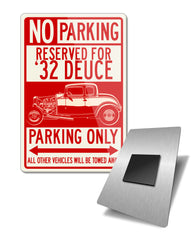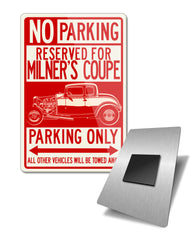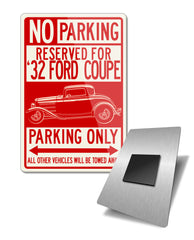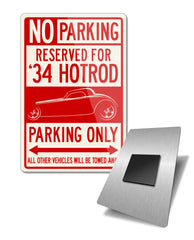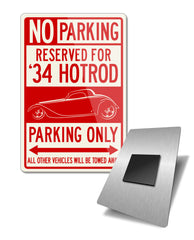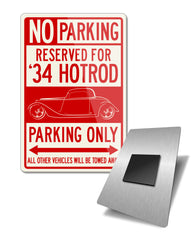

1973 Ford Gran Torino Sport Sportsroof Reserved Parking Fridge Magnet
1973 Ford Gran Torino Sport Sportsroof Aluminum Parking Fridge Magnet
The most obvious change for the 1973 model saw was a new front fascia, required to meet new federal regulations. The new regulation mandated that all cars manufactured after September 1, 1972, must be able to take a 5 mph (8.0 km/h) strike to the front without damaging safety related components such as headlamps and the fuel system. For 1973 only, rear bumpers had a 2.5 mph (4.0 km/h) requirement. The Torino's front end featured totally new sheetmetal from the firewall forward, with a blunt, more squared-off fascia replacing the previous year's pointed prow. The new large square 5 mph (8.0 km/h) energy absorbing bumper replaced the almost body-fitting chrome bumper used on the front of the 1972 Torino. The new larger bumpers caused all Torino models to increase in length by at least 1 in (25 mm), and weight also increased by at least 100 lb (45 kg) for all models. Rear bumpers and taillights were unchanged from 1972. For 1973, Gran Torino Sport had its own unique emblem, which it displayed in the grille and on the trunk lock cover. The laser stripe was revised to a slightly different shape, and ran higher along on the body side. The Sport no longer had a hood scoop, and the Ram Air induction option was gone. The Sport was available as a 2-door SportsRoof or a 2-door hardtop but was otherwise unchanged from the 1972 model year. In the Car and Driver magazine road test of a 1973 Gran Torino Sport, the suspension was noted to be a good balance of comfort and handling. Car and Driver wrote that the Torino was as "..quiet as a Jaguar, smooth as a Continental, the Torino's ride is exceptional...even with the competition suspension." Their test of a SportsRoof equipped with the 351 CJ, C-6 automatic, and 3.25:1 gears, resulted in a 0 – 60 mph time of 7.7 seconds while the quarter-mile went by in 16.0 seconds at 88.1 mph. The 0 – 60 mph time was 0.9 seconds slower than the 1972 model Car and Driver tested a year before; however, this can partially be attributed to differences in gear ratio, transmission type, and an almost 350 lb (160 kg) increase in weight. The 1973 Sport had a test weight of 4,308 lb (1,954 kg), while the 1972 had a test weight of 3,966 lb (1,799 kg).[24] For comparison, in a Motor Trend test of a 1970 Torino 2-door equipped with a 351-4V, Cruise-O-Matic, and 3.00:1 gears, they recorded a 0 – 60 mph time of 8.7 seconds, and a quarter-mile time of 16.5 seconds at 86 mph. However, the high compression 1970 motor required premium fuel, while the low compression 1973 motor could run on regular.
Perfect for all car enthusiasts that want to show their passion for their 1973 Ford Gran Torino Sport Sportsroof. Make room on the fridge and make it clear: Your 1973 Ford Gran Torino Sport Sportsroof deserves a reserved parking spot in the middle of the other magnets. The magnet is 2” x 3” (77 x 51 mm) and is quality made of .045” Aluminum that will not fade or break. It has rounded corner and a 1/2 inch square magnet in the back. Stick it to anything you'll like, on your fridge, workbench, toolbox, or man cave board. The colors are brights, vibrants and contrast beautifully. For any car guy, this is the ideal gift to add style and show their pride, even in the middle of the kitchen.
Available in: One color style only
- Made of 0.045” (1.14 mm) Durable Aluminum Material
- Size 3" x 2" (76.2 mm x 50.8 mm)
- Water-resistant & easy to clean
- 1” backer magnet for adhesion
The image is permanently infused into the aluminum that will not crack, fade, chip, or peel (we do not use stickers or decals).
- Made in USA
This product is made in the USA.



